

How Social Movements Change Minds. Marketers tend to like big, bold actions that grab attention and spew off metrics.

Yet all too often, we ignore the much more mundane work that comes before. To market a product or an idea, you have to change minds, and that takes time and a lot of careful work. That’s a lesson we’ve seen over and over in the social movements of the last century—although the outside observer may only notice the movement when the dominoes start falling, the people inside the movement worked tirelessly for months, years, or even decades, to change minds. The arc of history is long—the length of a career, rather than a marketing campaign.
And yet despite the differences, there are several lessons that marketers can learn from successful social movements. First, successful movements start by attacking perceptions. Consider the March on Washington in the summer of 1963. 12 Qualities of an Enlightened Person. By Charles A.

Francis. 7 Habits Of Innovative Thinkers. Many people believe that creativity and innovative thinking are traits that we are born with—we either have them or not.
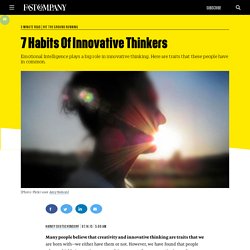
However, we have found that people who are highly innovative are a work in progress, forever questioning and examining themselves and the world around them. Far from being something we are born with, we can all become more innovative and creative by developing the traits that innovative people share. Here are some of the emotional intelligence-related attributes that innovative people share.
Artificial Intelligence and the Future of Work. The C-Suite Needs a Chief Entrepreneur. The best CEOs are excellent at growing and running a company within a known business model.

What they don’t do well enough is reinvent and innovate. It’s not because they’re incompetent, they just fall short at the task. Sure, there are exceptions who are both visionary CEOs and innovators — Steve Jobs and Jeff Bezos, for example — but there are very few companies that can stomach that sort of leadership. The Key To Creating Socially Conscious Businesses. On a broad scale, how do we create altruistic organizations that can really transform society and transform economic systems?
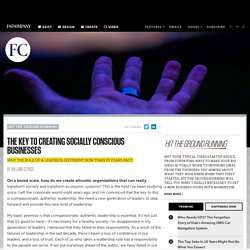
This is the field I’ve been studying since I left the corporate world eight years ago, and I’m convinced that the key to this is compassionate, authentic leadership. We need a new generation of leaders to step forward and provide this new kind of leadership. Science4-1.jpg (JPEG Image, 864 × 1757 pixels) - Scaled (57%) Get out of the Innovation Sandbox. A couple of months ago, I was at Techonomy 2014 and I am still digesting a fantastic interview with Peter Thiel and Reid Hoffman.
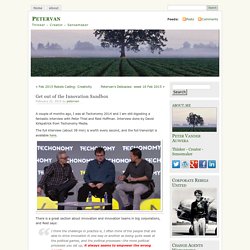
Interview done by David Kirkpatrick from Techonomy Media. How to Master the Craft of Strategy — Why One Decision can Make your Company and How to Get it Right — Evergreen Business Weekly. Oh man, I’m so excited for this Edition.
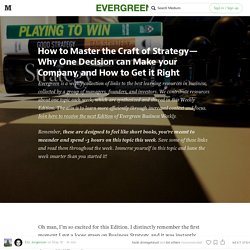
The Dirty Secret Behind Real Innovation: How Our Urge To Play Invented The Future. One of the most interesting things about writing books is the macroscopic picture that emerges when you’re done.

Larger patterns begin to reveal themselves, bigger questions start to arise. Take Tomorrowland, my latest book. While technically an examination of those moments in time when science fiction became science fact, the book inadvertently became a study in a very playful form of countercultural rebellion. To put this in simple terms, the larger pattern that revealed itself when I was writing this book is the undeniable fact that the men and women who have invented the future didn’t come from the mainstream.
Not even close. Small is Powerful: Escaping the 20th century love of big power. I'm planning to write a book over the next few months.
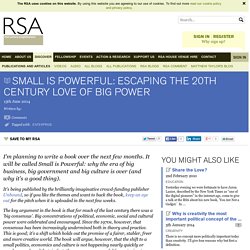
It will be called Small is Powerful: why the era of big business, big government and big culture is over (and why it's a good thing). It's being published by the brilliantly imaginative crowd-funding publisher Unbound, so if you like the themes and want to back the book, keep an eye out for the pitch when it is uploaded in the next few weeks. The key argument in the book is that for much of the last century there was a 'big consensus'. Big concentrations of political, economic, social and cultural power were celebrated and encouraged.
Adam Lent's blog. Inside Marriott’s Attempt To Win Over Millennials. The grand dames of the hotel industry—Marriott, Hilton, and Hyatt—built their reputations on creating a consistent, high-quality product that would ensure a guest had a perfectly predictable experience anywhere in the world.

This approach worked like a charm with baby boomers, who liked their premium hotel stays—much like their Starbucks macchiatos—to follow a neat formula. But millennials, it turns out, are different beasts altogether. Big hotel chains don’t interest them. Older millennials, now in their late twenties and early thirties, travel frequently. Zero – An Infinite Possibility. MIT's list of the 50 smartest companies. Famous Biologist Louis Agassiz on the Usefulness of Learning Through Observation. Louis Agassiz, the famous Swiss biologist, placed a fish specimen on the table in front of his post-graduate student.
“That’s only a sunfish,” the student said. “I know that,” Agassiz replied. He continued, “Write a description of it. Forget About Setting Goals. Focus On This Instead., by James Clear. We all have things that we want to achieve in our lives — getting into the better shape, building a successful business, raising a wonderful family, writing a best-selling book, winning a championship, and so on. And for most of us, the path to those things starts by setting a specific and actionable goal. The Condensed June 2015 Issue. Amy Bernstein, editor of HBR, offers executive summaries of the major features. For more, see the June 2015 issue. Download this podcast. The Planning Notepad by John Krissilas: Design Thinking Series.
Untitled. Dr Martin Bloem sur Twitter : "Great #infographic via @WyseEMEA: The 10 Most Important Work Skills in 2020 via @ssforumuk. Harvard Biz Review sur Twitter : "What Is a Business Model? Companies in Happy Cities Invest More for the Long Term. What Work Will Look Like In 2025. Future Trends in the Digital Workplace. Living Office. Work has changed. New Research Says Robots Are Unlikely to Eat Our Jobs. Video. Bits.blogs.nytimes. The four global forces breaking all the trends. In the Industrial Revolution of the late 18th and early 19th centuries, one new force changed everything. Today our world is undergoing an even more dramatic transition due to the confluence of four fundamental disruptive forces—any of which would rank among the greatest changes the global economy has ever seen. The eight essentials of innovation. It’s no secret: innovation is difficult for well-established companies. By and large, they are better executors than innovators, and most succeed less through game-changing creativity than by optimizing their existing businesses.
Lessons from Late Night. Letting Creative Cultures Flourish